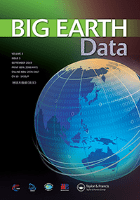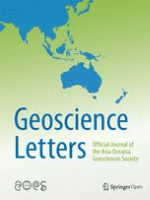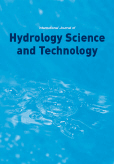
Journal of Earth System Science
Scope & Guideline
Driving Scientific Discourse on Climate Challenges
Introduction
Aims and Scopes
- Interdisciplinary Earth System Science:
The journal emphasizes research that integrates multiple disciplines such as geology, meteorology, oceanography, and environmental sciences to provide comprehensive insights into Earth system processes. - Climate Change and Environmental Impact Studies:
There is a strong focus on understanding climate change impacts, assessing environmental changes, and evaluating their implications for ecosystems and human societies. - Geophysical and Geochemical Analysis:
The journal publishes studies involving geophysical and geochemical methods to analyze subsurface structures, mineral deposits, and natural resources, which are crucial for understanding geological processes. - Natural Hazards and Risk Assessment:
Research addressing natural hazards, including earthquakes, landslides, and floods, along with their risk assessment and management strategies, is a key area of interest. - Remote Sensing and GIS Applications:
The use of remote sensing and geographic information systems (GIS) in monitoring and analyzing environmental phenomena, land use changes, and resource management is prominently featured. - Hydrology and Water Resources Management:
The journal includes studies on hydrological processes, water quality, and sustainable management practices to address water-related challenges. - Sustainable Development and Resource Management:
Research that focuses on sustainable practices in natural resource management, including energy, minerals, and water, is a critical aspect of the journal's scope.
Trending and Emerging
- Machine Learning and Big Data Applications:
There is a growing trend towards utilizing machine learning and big data analytics in various Earth science applications, including climate modeling, geological mapping, and resource management. - Climate Change Adaptation and Mitigation Strategies:
Research focusing on strategies for climate change adaptation and mitigation, including sustainable development practices, is increasingly prominent, reflecting global priorities. - Integrated Water Resource Management (IWRM):
The emphasis on integrated approaches to manage water resources sustainably, considering the interconnections between hydrology, ecology, and human activities, is gaining traction. - Urbanization and Its Environmental Impacts:
Studies investigating the impacts of urbanization on local climates, hydrology, and ecosystems are emerging as critical areas of research, especially in rapidly developing regions. - Geospatial Technologies in Environmental Monitoring:
The application of geospatial technologies, including remote sensing and GIS, for monitoring environmental changes and managing natural resources is increasingly featured in recent publications. - Resilience and Vulnerability Assessments:
Research focusing on assessing the resilience and vulnerability of communities and ecosystems to natural hazards and climate change is becoming more prominent, highlighting the need for adaptive strategies.
Declining or Waning
- Traditional Geological Surveys:
Papers focused solely on traditional geological surveys, without integrating modern methodologies like remote sensing or machine learning, have become less common as the field evolves towards more innovative approaches. - Historical Geological Studies:
Research primarily centered on historical geology, such as stratigraphic descriptions without contemporary relevance or application, appears to be waning as the focus shifts to current environmental issues and applications. - Basic Mineralogy without Environmental Context:
Studies that explore mineralogy in isolation, without linking findings to environmental issues or applications relevant to society, are less frequently published, indicating a shift towards applied research. - Purely Theoretical Geophysics:
Theoretical studies in geophysics, lacking practical applications or empirical validation, are becoming less favored in light of the growing demand for applied research that addresses real-world problems.
Similar Journals

Frontiers in Earth Science
Advancing Knowledge for a Sustainable PlanetFrontiers in Earth Science is a leading open-access journal published by FRONTIERS MEDIA SA, based in Switzerland. With its ISSN N/A and E-ISSN 2296-6463, this journal has firmly established itself in the realm of Earth and Planetary Sciences, evidenced by its exceptional Q1 ranking in the 2023 category of Earth and Planetary Sciences (miscellaneous) and a solid position of Rank #66/195 in Scopus, placing it in the 66th percentile among its peers. Since its inception in 2013, Frontiers in Earth Science has embraced the open access model, promoting widespread dissemination and accessibility of research findings. The journal covers a broad scope, including areas such as geology, meteorology, oceanography, and environmental science, fostering interdisciplinary communication and advancement. Researchers, professionals, and students looking to stay at the forefront of Earth science research will find an invaluable resource in this journal, which not only curates high-quality research but also supports innovative and impactful studies that address the pressing challenges facing our planet today.

Geosciences
Connecting Scholars to the Heart of Geoscience.Geosciences is a prestigious open-access journal published by MDPI, dedicated to advancing research in the field of Earth and Planetary Sciences. Since its inception in 2011, this journal has fostered a collaborative environment for the dissemination of innovative ideas and findings, contributing significantly to the academic community's understanding of complex geological processes. The journal has achieved a commendable 2023 ranking in the second quartile (Q2) within its category, highlighting its impact and relevance in the field, with a Scopus rank of #41 out of 195 journals, placing it in the 79th percentile. With an aim to span a broad range of topics from environmental geology to planetary exploration, Geosciences is pivotal for researchers, professionals, and students looking for an accessible platform to share their work and stay informed of the latest developments. As a fully open-access journal, it ensures that high-quality research is freely available, fostering greater dissemination of knowledge across the globe.

Big Earth Data
Exploring the Convergence of Earth Sciences and Data TechnologyBig Earth Data is a prestigious open-access journal that has been at the forefront of advancing research in the intersection of earth science and computer technology since its inception in 2017. Published by TAYLOR & FRANCIS LTD in the United Kingdom, this journal is dedicated to disseminating groundbreaking findings and innovative methodologies in the fields of Earth and Planetary Sciences and Computer Science Applications. With a commendable impact factor and an impressive positioning in the Scopus rankings—claiming Q1 status in Computers in Earth Sciences and Q2 in Computer Science Applications—it serves as a vital resource for researchers, professionals, and students alike. The journal encourages submissions that explore the integration of big data technologies in managing, analyzing, and visualizing earth-related data, thereby fostering interdisciplinary collaboration. Since embracing its open-access model, Big Earth Data has enhanced the accessibility of high-quality research, promoting a broader dialogue in the scientific community and contributing to informed decision-making in global environmental challenges.

Vietnam Journal of Earth Sciences
Charting New Frontiers in Earth and Planetary ExplorationThe Vietnam Journal of Earth Sciences, ISSN 0866-7187, is a premier publication from the Publishing House Science and Technology based in Viet Nam, dedicated to fostering advancements in the field of Earth and Planetary Sciences. Operating under a Q2 ranking in the 2023 category of Earth and Planetary Sciences (miscellaneous) and positioned at Rank #62 out of 195 in its general category on Scopus, this journal serves as a critical platform for researchers, professionals, and students seeking to disseminate and engage with high-quality scientific findings. Despite being part of the non-open access model, the journal is committed to providing compelling content, encompassing a range of topics from geological hazards to environmental sustainability, ensuring its relevance and contribution to both local and international scientific communities. With coverage that spans from 2018 to 2024, the journal is poised to continue its role in addressing pressing Earth science issues and fostering collaborations among scholars in an increasingly interconnected world.

Geofizika
Empowering Geophysics Through Open KnowledgeGeofizika, an esteemed journal published by the Andrija Mohorovičić Geophysical Institute at the University of Zagreb, presents a significant platform for research in the fields of geophysics and Earth sciences. With an Open Access model established since 1984, this journal ensures that scientific knowledge is accessible to a broad audience, encouraging collaborations and the free exchange of ideas. Geofizika has steadily evolved through its converging years from 1989 to 1999 and has been active from 2003 to the present, reflecting its commitment to advancing geophysical research. The journal has been recognized for its contributions to Earth and Planetary Sciences and has acquired respectable ranks in various categories; notably, it holds a Q4 status in Geophysics as of 2023. Researchers, professionals, and students will find Geofizika a valuable resource for the latest discoveries and methodologies in geophysics, supporting the academic community in expanding the frontiers of knowledge in these vital scientific domains.

Geoscience Letters
Pioneering Open Access in Earth SciencesGeoscience Letters, published by Springer, is a prominent open-access journal in the field of Earth and Planetary Sciences, recognized for its dedication to advancing knowledge and research in this vital area of study. With a reported impact factor that reflects its esteemed position—ranking in the Q1 quartile of Earth and Planetary Sciences, particularly as the journal ranks #48 out of 195 in the general category according to Scopus—the journal serves as a vital resource for researchers, professionals, and students. Since its inception in 2014, Geoscience Letters has facilitated the dissemination of high-quality research and critical insights, aiming to bridge the gap between scientific discovery and societal needs. Its commitment to open access ensures that the latest findings are readily available to a global audience, thus enhancing collaboration and innovation within the geosciences community.

Journal of Mountain Science
Advancing Insights into Earth's Majestic Mountain EnvironmentsThe Journal of Mountain Science, published by SCIENCE PRESS, is a distinguished academic journal dedicated to advancing the understanding of mountain environments and their significance in various scientific domains. With an ISSN of 1672-6316 and an E-ISSN of 1993-0321, this journal has carved a niche in the field of Earth sciences, earning a commendable Q2 ranking in categories such as Earth-Surface Processes, Geography, Planning and Development, and Geology, as well as a Q3 ranking in Global and Planetary Change. Since its inception in 2007, the journal has been pivotal in fostering interdisciplinary research that addresses critical environmental issues, making it an essential resource for researchers, professionals, and students alike. While currently not offering open access, it provides valuable insights into areas including nature conservation and landscape management, with a focus on the unique challenges faced by mountainous regions. Located in Beijing, China, the Journal of Mountain Science continues to promote scholarly discourse that contributes to the sustainable development of mountain communities and ecosystems until 2024 and beyond.

International Journal of Hydrology Science and Technology
Shaping the Future of Hydrology with Cutting-edge ResearchThe International Journal of Hydrology Science and Technology, published by InderScience Enterprises Ltd, is a distinguished platform dedicated to advancing knowledge in the field of hydrology, environmental engineering, and water science. With an ISSN of 2042-7808 and an E-ISSN of 2042-7816, this journal, established in 2011 and continuing through 2024, serves as an essential resource for researchers, professionals, and students alike. Despite being categorized in the Q3 quartile across multiple disciplines including Earth and Planetary Sciences, Environmental Engineering, Waste Management and Disposal, and Water Science and Technology, the journal maintains a reputation for contributing significant findings that impact both theory and practical applications in addressing hydrological challenges. Currently unavailable through Open Access options, the journal remains committed to disseminating valuable research that informs sustainable practices in water resource management. The editorial team encourages submissions that explore innovative strategies and methodologies while fostering interdisciplinary discussions, making this journal a pivotal player in shaping the future of hydrological science.

DOKLADY EARTH SCIENCES
Unveiling Insights into Our Planet's DynamicsDOKLADY EARTH SCIENCES is a reputable journal published by MAIK NAUKA/INTERPERIODICA/SPRINGER, focusing on the dynamic field of Earth and Planetary Sciences. With an ISSN of 1028-334X and E-ISSN 1531-8354, this journal offers a platform for researchers to disseminate their findings and insights that contribute to our understanding of Earth systems over a continuous publishing span from 1998 to 2024. It currently holds a Q3 quartile ranking in the Earth and Planetary Sciences category, reflecting an emerging yet significant impact within its field, evidenced by its Scopus ranks where it stands at 123rd in general Earth sciences and 113th in miscellaneous Earth sciences. DOKLADY EARTH SCIENCES aims to bridge research gaps and foster collaboration among a diverse audience including researchers, professionals, and students committed to advancing knowledge in geoscience. The journal stands as a vital resource for those seeking to explore contemporary challenges and innovations within the realm of Earth sciences.

Science China-Earth Sciences
Advancing Knowledge in Earth and Planetary Sciences.Science China-Earth Sciences, published by SCIENCE PRESS, stands as a leading journal in the field of Earth and Planetary Sciences, currently holding a prestigious Q1 ranking in the 2023 category and positioned at Rank #12 out of 195 in Scopus, reflecting its significance with an impressive 94th percentile. Specializing in a wide array of topics including geological processes, environmental science, and planetary studies, the journal serves as a vital resource for researchers, professionals, and students alike, fostering interdisciplinary collaboration and advanced scientific discourse. With a commitment to accessibility and knowledge dissemination, Science China-Earth Sciences offers an Open Access model, ensuring that high-quality research is available to a global audience. Situated in Beijing, China, this journal is dedicated to promoting innovative scientific advancements and understanding the complexities of our planet from 2010 to 2024 and beyond. As such, it remains essential for anyone engaged in the dynamic and evolving field of Earth sciences.